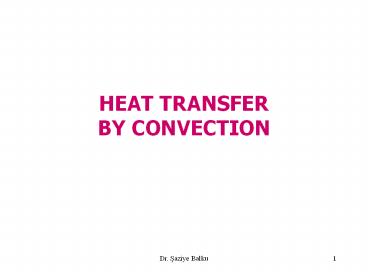HEAT TRANSFER BY CONVECTION CONDUCTION Mechanism of heat - PowerPoint PPT Presentation
1 / 21
Title:
HEAT TRANSFER BY CONVECTION CONDUCTION Mechanism of heat
Description:
HEAT TRANSFER BY CONVECTION CONDUCTION Mechanism of heat transfer through a solid or fluid in the absence any fluid motion. CONVECTION Mechanism of heat transfer ... – PowerPoint PPT presentation
Number of Views:1930
Avg rating:3.0/5.0
Title: HEAT TRANSFER BY CONVECTION CONDUCTION Mechanism of heat
1
HEAT TRANSFER BY CONVECTION
2
- CONDUCTION
- Mechanism of heat transfer through a solid or
fluid in the absence any fluid motion. - CONVECTION
- Mechanism of heat transfer through a fluid in the
presence of bulk fluid motion - Natural (free) Convection
- Forced Convection
- (depending on how the fluid motion is initiated)
3
CLASSIFICATION OF FLUID FLOWS
- Viscous-inviscid
- Internal flow-
- External flow
- Open-closed channel
- Compressible-
- Incompressible
- Laminar-
- Turbulent
- Natural- Forced
- Steady- Unsteady
- One-,two-,three-dimensional
4
VISCOSITY
- When two fluid layers move relative to each
other, a friction force develops between them and
the slower layer tries to slow down the faster
layer. - internal resistance to flow
- cohesive forces between the molecules in liquid
- molecular collisions in gases.
- Viscous flows viscous effects are significant
- Inviscid flow regions viscous forces are
negligibly small compared to inertial or pressure
forces. - measure of stickness or resistance to
deformation - Kinematic viscosity
- Dynamic viscosity
5
VISCOSITY DEPENDS ON
- TEMPERATURE
- PRESSURE
- For liquids dependence of pressure is negligible
- For gases kinematic viscosity depends on
pressure since its relation to density
Dynamic viscosity (kg/m.s or poise)
Kinematic viscosity, m2/s or stroke
6
- Convection heat transfer
- Dynamic viscosity
- Thermal conductivity
- Density
- Specific heat
- Fluid velocity
- Geometry
- Roughness
- Type of fluid flow
7
NEWTONS LAW OF COOLING
(W)
Convection heat transfer coefficient
(W/m2.0C) The rate of heat transfer between a
solid surface and a fluid per unit surface area
per unit temperature difference
8
GENERAL THERMAL ANALYSIS
9
FORCED CONVECTION
10
- LAMINAR FLOW
- Smooth streamlines
- Highly- ordered motion
- (highly viscous fluids in small pipes)
- TURBULENT FLOW
- Velocity fluctuations
- Highly-disordered motion
- TRANSITIONAL FLOW
11
REYNOLDS NUMBER
Ratio of the inertial forces to viscous forces in
the fluid
Flow Regime Geometry Surface roughness Flow
velocity Surface temperature type of fluid
Mean flow velocity Characteristic length of the
geometry Kinematic viscosity
12
- Critical Reynolds number (Recr) for flow in a
round pipe - Re lt 2300 ? laminar
- 2300 Re 4000 ? transitional
- Re gt 4000 ? turbulent
- Note that these values are approximate.
- For a given application, Recr depends upon
- Pipe roughness
- Vibrations
- Upstream fluctuations, disturbances (valves,
elbows, etc. that may disturb the flow)
Definition of Reynolds number
13
HYDRAULIC DIAMETER
- For non-round pipes,
- the hydraulic diameter Dh 4Ac/P
- Ac cross-section area
- P wetted perimeter
14
Velocity No-slip condition
15
THERMAL BOUNDARY LAYER
Flow region over the surface in which the
temperature variation in the direction normal to
the surface Velocity profile influences
temperature profile
16
VELOCITY
A flow field is best characterized by the
velocity distribution, and velocity may vary in
three dimension
- in rectangular
in cylinderical coordinates
One dimensional flow in a circular pipe
In which direction does the velocity change in
this figure???
17
NUSSELT NUMBER
(Dimensionless number)
18
PRANDTL NUMBER
- Boundary layer theory
Prltlt1 heat diffuses very quickly in liquid
metals, tbl thicker Prgtgt1 heat diffuses very
slowly in oils relative to momentum, tbl thinner
than vbl
19
PARALLEL FLOW OVER FLAT PLATES
laminar
turbulent
20
NATURAL CONVECTION
21
CONVECTIVE HEAT TRANSFER COEFFICIENT
Coefficient of volume expansion
Grashof number Rayleigh number Prandtl
number Nusselt number
viscosity
Table 20-1

